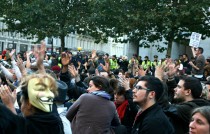The Consesus Process
Across the world the Occupy movement is using consensus decision-making
to reach agreements.
Making a consensus decision about a proposal follows a basic format. An individual shares what is being proposed, why it is being proposed, and, if there is enough agreement, how it can be carried out. The General Assembly will express its opinion for each proposal through a series of hand gestures. If there is positive consensus for a proposal – meaning no outright opposition – then it is accepted and the proposed action will be taken.
Why use Consensus?
Consensus is a creative thinking process:
When we vote, we decide between two alternatives. With consensus, we takean issue, hear the range of enthusiasm, ideas and concerns about it, and synthesizea proposal that best serves everybody’s vision. It is a search for the place that allows the group to go forward together.
Consensus values every voice:
The care we take in a consensus process to hear everyone’s opinions and weave them into a whole is a living demonstration that each one of us is important. It’s a counter to systems that tell us some people count while others don’t. In consensus, everyone matters. But for consensus to work, we must also be flexible,
willing to let go. Consensus means you get your say—it doesn’t mean you get your way!
Consensus creates a sense of unity:
When we all participate in shaping a course of action, we all feel a sense of commitment
and responsibility. Unity is not unanimity—within consensus there is room for disagreement, for objections, reservations, for people to stand aside and not participate.
Hand signals:
A number of these are used to make meetings more participatory and efficient. The best place to pick these up is at a General Assembly (GA).
Want to know more?
Attend a workshop on consensus at the occupation – keep an eye on the event list for these.




